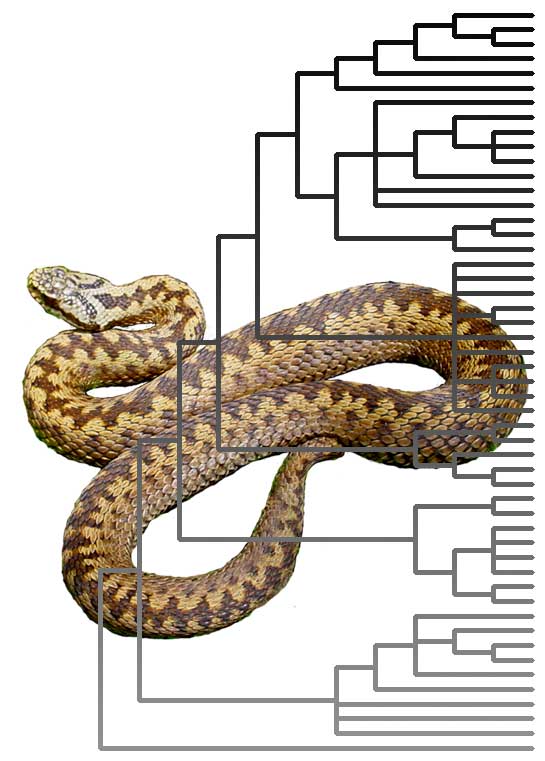
| phylogeography, phylogeny and systematics | population genetics and ecology | conservation and alien species |
Phylogegraphy and glacial refugial
area in Europe
During my PhD, I have studied the phylogeography of three European vipers, the asp viper (Vipera aspis), the common adder (V. berus) and the nose-horned viper (V.ammodytes). The results showed a stronger genetic diversity than previously supposed, especially in V. ammodytes. The occurrence of numerous refugia used by this species during the last glaciations in Balkans peninsula is considerable and confirmed the necessity of more phylogeographical studies in this region. The adder showed an unsuspected clade in Italy and a huge genetic variability in the northern clade due to the use of several small refugia located North of the Alps during the last glaciation. The asp viper displayed a more common pattern (Spain and Italian refugia), but the occurrence of a small southern France refugia was demonstrated. Indeed, most of the reptiles are ideal taxon to understand complex recolonisation patterns due to the low colonisation rate, their ability to survive in small refugia and the hibernation capacity.
• URSENBACHER S., SCHWEIGER S., TOMOVIC L., CRNOBRNJA-ISAILOVIC
J., FUMAGALLI L. & MAYER W. (2008) Molecular phylogeography of the nose-horned
viper (Vipera ammodytes, Linnaeus (1758)): Evidence for high genetic diversity
and multiple refugia in the Balkan peninsula, Molecular Phylogenetics and Evolution
46 (3) 1116-1128
• URSENBACHER S., CONELLI A., GOLAY P., MONNEY J.-C.,
ZUFFI M. A. L., THIERRY G., DURAND T. & FUMAGALLI L. (2006) Phylogeography
of the asp viper (Vipera aspis) inferred from mitochondrial DNA: Evidence for
multiple Mediterranean refugial areas, Molecular Phylogenetics and Evolution
38 (2) 546-552
• URSENBACHER S., CARLSSON M., HELFER V., TEGELSTROM H. & FUMAGALLI
L. (2006) Phylogeography and Pleistocene refugia of the adder (Vipera berus)
as inferred from mitochondrial DNA sequence data, Molecular Ecology 15 (11)
3425-3437
Phylogeny
In collaboration with Anne-Laure Ferchaud and numerous persons in the Europe, we are presently working on the phylogegraphy of the Vipera ursinii complex (regrouping all taxa of the sub-genus Acridophaga). The results will be submitted soon.
Systematics
Based on the genetic results, morphological analyses are curently conducted in order to evaluate if morphological differentiations can be observed between genetic clades isolated since 1 million years (or more) or if selection on morphology conducted taxa to maintain a similar morphology.
In Vipera berus, some morphological differences were found between the Italian and the Northern clades. Owever, additional analyses should be conduted. For Vipera aspis, a collaboration implying Philippe Golay(Elapsoidea, Geneva) and Jean-Claude Monney (karch, Neuchâtel) allow to discover that some morphological caracters are mainly influenced by the environemental parameters such as temperature or humidity. The high genetic differenciation observed in the sand viper (Vipera ammodytes) in the Central Balkan region seems not to be correlated to morphological differences detected by the different publication of Ljiljana Tomovic (University of Belgrade, Serbia) and collaborators. Consequently, we initiated a collobaration with Lijliana and Silke Schweiger (Naturhistorische Museum, Vienna) to continue the phylogography work, detect the contact zone between some genetic clades and improve the morphological knowledge of this species.
• URSENBACHER S., SASU I., ROSSI M. & MONNEY J.-C.
(2005) Are there morphologicaldifferences between two genetically differentiated
clades in the adder Vipera berus berus?, in: Herpetologia Petropolitana, Proccedings
of the 12th Ordinary Meeting of Societas Europaea Herpetologica (SEH) (eds.
ANANJEVA N. & TSINENKO O.), Saint-Petersburg, Russia 96-98
• GOLAY P., MONNEY J.-C., CONELLI A., DURAND T., THIERY G., ZUFFI M.
A. L. & URSENBACHER S. (2008) Systematics of the Swiss asp vipers: some
implications for the European Vipera aspis (Linnaeus 1758) complex (Serpentes:
Viperidae) — A tribute to Eugen Kramer, Amphibia-Reptilia 29 71-83